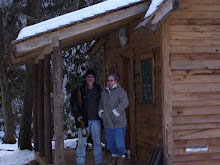The Mountain Laurel
The Mountain Laurel growing along the stream and waterfall banks played a large part in the decision as to where we would build our cabin. We had never seen such gigantic shrubs. We were not even sure they were the typical Mountain Laurel normally seen in the mountains of North Carolina and Virginia that grow along the Appalachian and Blue Ridge Mountains. After doing some research, we found they certainly were one and the same.
Some information we found here:
Mature plants are 6.5 to 10 feet tall, but may reach up to 40 feet in height. The leaves are usually 3/4 inch to 4 inches long, and 1 to 2 inches wide.
Mountain Laurel is usually a tall, spreading shrub throughout most of its range, yet in the fertile Blue Ridge valleys and in the Allegheny Mountains of the southern Appalachian Mountains mountain-laurel may attain the size of a small tree.
In 1877, botanist Asa Gray noted at Caesar's Head in extreme northwest South Carolina that the trunks of mountain-laurel reached 50 inches (125 cm) in circumference. Mountain-laurel burl size varies with age. A 600-pound (272 kg) burl has been reported in western North Carolina.
Mountain Laurel growing along the stream in all its glory! Note how small the 5 foot 4 inch person looks standing to the left of the Mountain Laurel. Sort of shows how big the Mountain Laurel is growing next to her even though she is a little distance away.
Mountain Laurel
There are many wild flowers, herbs, and berries that grow along this area. We find more with every season.
We have a never ending supply of Jewelweed (Impatiens capensis) growing along both sides of the waterfall and streams with which we have made soap and salves.
Jewelweed
Jewelweed, otherwise known as Touch-Me-Nots is best known for its skin healing properties. The leaves and the juice from the stem of Jewelweed are used by herbalists as a treatment for poison ivy, oak and other plant induced rashes, as well as many other types of skin problems. Poultices and salves from Jewelweed are a folk remedy for bruises, burns, cuts, eczema, insect bites, sores, sprains, warts, and ringworm.
We have access to more Jewelweed than we could ever use growing along the stream bank. It blooms during the months of May through October and that is when I find it to be most effective when using it for poison ivy or other skin irritations.
I double infused it in olive oil and use it to make salves, soap, and more.
More on infusing oils in a later post.
Caution if using this recipe! Lye is VERY caustic. Please take the time to read about safety precautions when working with lye here.
Jewelweed Soap Recipe
4 oz Cocoa Butter
16 oz Coconut Oil
16 oz Palm Kernel
16 oz Palm Oil
25 oz Olive Oil (double infused with Jewelweed)
teaspoon or so of Vitamin E
11.1 Oz Lye (if you use this recipe, please run through a lye calculator.
20 oz of water that has been made into a tea with Peppermint Leaves (not the peppermint teabags you buy at the grocery store).
about 2 tablespoons of Pine Tar
About 2 Tablespoons of Peppermint Leaves
Melt your pine tar along with the first four oils
Add the Olive Oil and bring the oils to temp
Use your normal safe soaping lye/oil soaping procedure













No comments:
Post a Comment